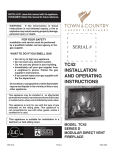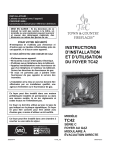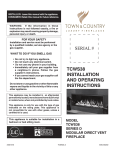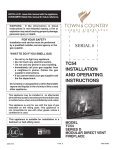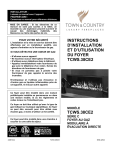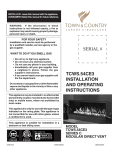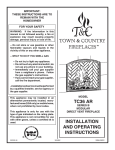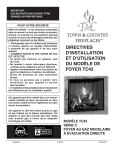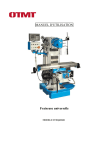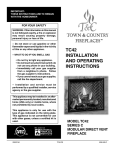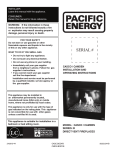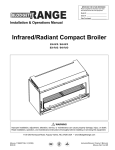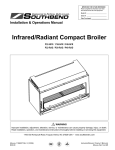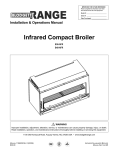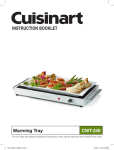Download serial # tc42.ce3 installation and operating instructions
Transcript
INSTALLER: Leave this manual with the appliance. CONSUMER: Retain this manual for future reference. WARNING: If the information in these instructions is not followed exactly, a fire or explosion may result causing property damage, personal injury or death. FOR YOUR SAFETY Do not store or use gasoline or other flammable vapors and liquids in the vicinity of this or any other appliance. SERIAL # WHAT TO DO IF YOU SMELL GAS • • • • Do not try to light any appliance. Do not touch any electrical switch; Do not use any phone in your building. Immediately call your gas supplier from a neighbour’s phone. Follow the gas supplier’s instructions. • If you cannot reach your gas supplier call the fire department. Installation and service must be performed by a qualified installer, service agency or the gas supplier. TC42.CE3 INSTALLATION AND OPERATING INSTRUCTIONS This appliance may be installed in an aftermarket permanently located, manufactured home (USA only) or mobile home, where not prohibited by local codes. This appliance is only for use with the type of gas indicated on the rating plate. This appliance is not convertible for use with other gases, unless a certified kit is used. This appliance is suitable for installation in a bedroom or bed sitting room. 250313-44 TC42_CE3 MODEL TC42 SERIES C MODULAR DIRECT VENT FIREPLACE 5056.426C2 Table of Contents Caution ........................................................................................... 3 Safety ............................................................................................. 3 Fireplace Dimensions ..................................................................... 5 Minimum Clearances to Combustible Material ............................... 5 Installation Requirements ............................................................... 6 Manufactured (Mobile) Home ......................................................... 6 Window Frame Removal ................................................................. 6 Locating The Fireplace ................................................................... 7 Top Standoffs .................................................................................. 7 Framing and Finishing .................................................................... 8 TC42 Steel Stud Framing Kit ........................................................ 10 Adjustable Lintel ........................................................................... 12 Hearth Extension .......................................................................... 13 Maestro Control ........................................................................... 14 Plumbing and Electrical ................................................................ 14 Gas Supply ................................................................................... 17 Gas Pressure Check ..................................................................... 17 Venting.......................................................................................... 18 Wall Termination Venting .............................................................. 18 Wall Termination Venting Chart..................................................... 21 Roof Termination Venting Chart .................................................... 22 Vent Terminal Clearance............................................................... 25 Vent Terminal Minimum Clearances ............................................. 25 Vent Pipe Sealant ......................................................................... 26 Vent Restrictor Adjustment ........................................................... 27 Firebox Panels Installation ............................................................ 28 Finishing Touch Trim Kit Instructions............................................. 29 Lighting Instructions ..................................................................... 30 First Fire ........................................................................................ 30 Maestro Control System ............................................................... 31 Remote Control Initial Setup ......................................................... 31 Maestro Control System - Operation ............................................ 32 Maintenance ................................................................................. 35 TC42.CE2 Replacement Parts ..................................................... 36 Replacement Parts – Maestro Control System ............................. 37 Wiring Diagram ............................................................................. 38 Wall Termination Kit .................................................................... 39 Roof Termination Kit ................................................................... 39 Wall Shield/ ................................................................................... 39 Ceiling Firestop Thimble ............................................................... 39 Vent Pipe Dimensions ................................................................. 40 Vent Offset Chart .......................................................................... 41 Light Replacement........................................................................ 42 Safety Label Location ................................................................... 43 TC42_CE3 250313-44 2 Caution FOR YOUR SAFETY - Do not install or operate your Town & Country fireplace without first reading and understanding this manual. Any installation or operational deviation from the following instructions voids the Town & Country FireplacesTM Warranty and may prove hazardous. This appliance and its individual shut off valve must be disconnected from gas supply piping system during any pressure testing of that system at test pressures in excess of 1/2 psig (3.5 kPa). This appliance must be isolated from the gas supply piping system by closing its individual manual shut off valve during any pressure testing of the gas supply piping system at test pressures equal to or less than 1/2 psig (3.5 kPa). Note: When lit for the first time, the appliance will emit a slight odour for a couple of hours. This is due to the curing of paints, sealants and lubricants used in the manufacturing process. This condition is temporary. Open doors and windows to ventilate area. Smoke and fumes caused by the curing process may cause discomfort to some individuals. Do not use the fireplace if any part has been under water. Immediately call a qualified service technician to inspect the fireplace and to replace any part of the control system and any gas control which has been under water. Safety Due to high temperatures, this gas appliance should be located out of traffic and away from furniture and draperies. Children and adults should be alerted to the hazards of high surface temperatures and should stay away to avoid burns or clothing ignition. Young children should be carefully supervised when they are in the same room as the appliance. Clothing or other flammable material should not be placed on or near the appliance. Any grill, panel or door removed for servicing the unit must be replaced prior to operating. Failure to do so may create a hazardous condition. Installation and repair should be done by a qualified service person. The appliance should be inspected before use and at least annually by a professional service person. More frequent cleaning may be required due to excessive lint from carpeting, bedding material, etc.. It is imperative that control compartments, burners and circulating air passageways of the appliance be kept clean. It is our policy that no responsibility is assumed by the Company or by any of its employees or representatives for any damages caused by an inoperable, inadequate, or unsafe condition which is the result, either directly or indirectly, of any improper operation or installation procedures. This appliance must not be connected to a chimney flue serving a separate solid fuel burning appliance. TC42_CE3 250313-44 3 We recommend that our gas hearth products be installed and serviced by professionals who are certified in the United States by the National Fireplace Institute® (NFI) as NFI Gas Specialists Important Note for the Commonwealth of Massachusetts: From Massachusetts Rules and Regulations 248 CMR 5.08: (a) For all side wall horizontally vented gas fuelled equipment installed in every dwelling, building or structure used in whole or in part for residential purposes, including those owned or operated by the Commonwealth and where the side wall exhaust vent termination is less than seven (7) feet above finished grade in the area of the venting, including but not limited to decks and porches, the following requirements shall be satisfied. 1. INSTALLATION OF CARBON MONOXIDE DETECTORS. At the time of installation of the side wall horizontal vented gas fuelled equipment, the installing plumber or gas fitter shall observe that a hard wired carbon monoxide detector with an alarm and battery back-up is installed on the floor level where the gas equipment is to be installed, in addition, the installing plumber or gas fitter shall observe that a battery operated or hard-wired carbon monoxide detector with an alarm is installed on each additional level of the dwelling, building or structure served by the side wall horizontal vented gas fuelled equipment. It shall be the responsibility of the property owner to secure the services of qualified licensed professionals for the installation of hard-wired carbon monoxide detectors. a. In the event that the side wall horizontally vented gas fuelled equipment is installed in a crawl space or an attic, the hard-wired carbon monoxide detector with alarm and battery back-up may be installed on the next adjacent floor level. b. In the event that the requirements of this subdivision cannot be met at the time of completion of installation, the owner shall have a period of thirty (30) days to comply with the above requirements; provided, however, that during said thirty (30) day period, a battery operated carbon monoxide detector with an alarm shall be installed. 2. APPROVED CARBON MONOXIDE DETECTORS. Each carbon monoxide detector as required in accordance with the above provisions shall comply with NFPA 720 and be ANSI/UL 2034 listed as IAS certified. 3. SIGNAGE. A metal or plastic identification plate shall be permanently mounted to the exterior of the building at a minimum height of eight (8) feet above grade directly in line with the exhaust vent terminal for the horizontally vented gas fuelled heating appliance or equipment. The sign shall read, in print size no less than one-half (1/2) inch in size, “GAS VENT DIRECTLY BELOW. KEEP CLEAR OF ALL OBSTRUCTIONS”. 4. INSPECTION. The state or local gas inspector of the side wall horizontally vented gas fuelled equipment shall not approve the installation unless, upon inspection, the inspector observes carbon monoxide detectors and signage installed in accordance with the provisions of 248 CMR 5.089(2)(a) 1 through 4. (b) EXEMPTIONS. The following equipment is exempt from 248 CMR 5.089(2)(a) 1 through 4. 1. The equipment listed in Chapter 10 entitled “Equipment Not Required To Be Vented” in the most current edition of NFPA 54 as adopted by the Board; and 2. Product Approved side wall horizontal vented gas fuelled equipment installed in a room or structure separate from the dwelling, building or structure used in whole or in part for residential purposes. (c) MANUFACTURER REQUIREMENTS – GAS EQUIPMENT VENTING SYSTEM PROVIDED. When the manufacturer of Product Approved side wall horizontally vented gas equipment provides a venting system design or venting system components with the equipment, the instructions provided by the manufacturer for installation of the equipment and the venting system shall include: 1. Detailed instructions for the installation of the venting system design or the venting system components; and 2. A complete parts list for the venting system design or venting system. (d) MANUFACTURER REQUIREMENTS – GAS EQUIPMENT VENTING SYSTEM NOT PROVIDED. When the manufacturer of a Product Approved side wall horizontally vented gas fuelled equipment does not provide the parts for venting the fuel gases, but identifies “special venting systems”, the following requirements shall be satisfied by the manufacturer. 1. The referenced “special venting system” instructions shall be included with the appliance or equipment installation instructions; and 2. The “special venting systems” shall be Product Approved by the Board, and the instructions for that system shall include a parts list and detailed installation instructions. (e) A copy of all installation instructions for all Product Approved side wall horizontally vented gas fuelled equipment, all venting instructions, all parts lists for venting instructions, and/or all venting design instructions shall remain with the appliance or equipment at the completion of the installation. TC42_CE3 250313-44 4 Fireplace Dimensions Fig. #1 13 13/16 11 11/16 52 3/8 29 7/16 53 15/16 26 3/4 42 1/4 38 3/16 43 9/16 43 9/16 26 3/4 Minimum Clearances to Combustible Material Fig. #2 STEEL FRAMING COMBUSTIBLE FRAMING AND FINISH WALL ABOVE STANDOFFS STANDOFFS NON-COMBUSTIBLE ZONE. DO NOT INSTALL ANY COMBUSTIBLE MATERIAL, ELECTRICAL WIRING OR GAS PLUMBING IN THIS AREA. MAY USE COMBUSTIBLE FACING MATERIAL IN THIS AREA NON-COMBUSTIBLE FINISH MATERIAL SEE FIG #8 MANTEL CLEARANCE CHART * MANTEL CLEARANCE D E F A B C A 9” B 6” C 3” ** MANTEL DEPTH TOP OF LINTEL BAR FIREPLACE FRONT D 12” E 6 3/4” F 1 1/2” Fig. #3 Minimum Clearances: CEILING ** MANTEL ADJACENT WALL OR MANTEL SUPPORT " 24” 24 * Side standoffs ....................................................... 0 in. (0 mm) Back standoffs ...................................................... 0 in. (0 mm) Top standoffs ........................................................ 0 in. (0 mm) Bottom of appliance .............................................. 0 in. (0 mm) Adjacent side wall ................................................. 4 in. (102 mm) Ceiling to appliance ............................................ 24 in. (610 mm) *Mantel to appliance .................. ..........See Figure #2 4” 4" **Maximum Mantel extension " 38 1/81/8” 38 UNIT MAY BE RECESSED UP TO 6” WITH NON-CUMBUSTIBLE MASONRY TYPE MATERIAL TC42_CE3 250313-44 5 .. ..........See Figure #2 Mantel support ...................................................... 4 in. (102 mm) Vertical vent pipe ..........................................1 3/4" in. (45 mm) Horizontal Vent pipe (Top, sides and bottom) 1 3/4" in. (45 mm) Installation Requirements The Town & Country Fireplace installation and venting must conform to the current CAN/CGA-B149 installation code (in Canada) or the current National Fuel Gas Code, ANSI Z223.1 (in the USA), and approved per local codes. Only qualified (licensed or trained) personnel should install this product. In the state of Massachusetts, only a licensed Plumber and Gas Fitter may install this product. Fig. #4 Manufactured (Mobile) Home In some jurisdictions, the Town & Country Fireplace may be installed in Manufactured Homes after the "first sale". Consult local codes for approval. The fireplace must be fastened in place. Install in accordance with the current standard Mobile Homes, CAN/CSA Z240 MH (in CANADA), and the Manufacturer's Home Construction and Safety Standard, Title 24 CFR, Part 3280 or the current Standard for Fire Safety Criteria for Manufactured Home Installations, Sites and Communities ANSI/NFPA 501A (in the USA). Fig. #5 Window Frame Removal Warning: Turn off the fireplace, and allow ample time for the unit to cool before proceeding. Caution: The ceramic glass is very fragile, and should be handled with care. The window frame is held in place by two spring-loaded latches that are operated by a one-piece latch handle. 1. Remove the TC Finishing Touch Trim Kit from the window frame. (If installed) 2. Using a screwdriver or other similar object, push against the notch in the top of the latch and grab the bottom of the latch handle as it protrudes. Lift handle until latch hook disengages. Repeat for other side while holding glass so it does not tip out. LATCH HANDLE 3. Tilt the top of the window frame out to clear the top edge of the unit. Grasp the sides of the frame and lift up and out to disengage from its bottom track. 4. Place the window frame in a safe place to avoid damage. 5. Re-assemble in reverse order. Latch handle should snap into place and be flush with window frame when engaged correctly. TIP: To ensure glass is properly latched, grasp the top left and right sides of the glass frame, under moderate pressure it should pull forward and return to original position evenly on both sides. 6. Reinstall Trim Kit if required. TC42_CE3 250313-44 6 Top Standoffs The top standoffs are shipped loose inside the fireplace and must be installed on top of the fireplace as shown in Fig #6. Do this once the fireplace is on site and in position. Fig. #6 TOP STANDOFFS Locating The Fireplace In planning the installation for the fireplace, it is necessary to determine where the unit is to be installed, location of vent system and where gas supply piping may be plumbed. Various installations are possible, such as, into an existing wall, a corner, a built-in wall or a wall projection (Fig #7). Due to high temperatures, do not locate this fireplace in areas of high traffic or near furniture or draperies. The minimum clearances from the fireplace to combustible surfaces must be adhered to and are shown in Fig #2 and Fig #3. Fig. #7 EXAMPLES OF COMMON LOCATIONS SEE FIG #11 FOR DIMENSIONS TC42_CE3 250313-44 7 Framing and Finishing Note: The fireplace should be in place and venting installed before framing in or building an enclosure around the unit. The Town & Country fireplace must be framed in as described below or totally enclosed with non-combustible material, such as facing brick. Determine the total thickness of facing material to be used. A thickness of 3/4" will allow the finishing surface to be flush with the front of the unit. If preferred, additional masonry type non-combustible material can be installed above and to the sides up to 6 inches proud of the appliance. The finishing material must not interfere with glass frame access. A Steel Stud Framing Kit is supplied with the fireplace and must be used unless the fireplace is totally enclosed with non-combustible material. Assemble the framing kit as per the instructions on pages 10 & 11 of this manual. Attach the steel frame to the fireplace once the fireplace is in its final position. Secure the steel frame to the framing brackets on each side of the unit. Ensure that the studs are set back far enough to allow for thickness of finishing surface. The sides, back and top of the fireplace can be framed in up to the steel studs and the fireplace standoffs using conventional lumber. Consult local building codes for specific requirements. Due to high temperatures, non-combustible backer board, such as cement board or its equivalent, must be used to sheet in the front of the fireplace, extending 12" above and 5 1/2" to the side of the framing edge bars. (Fig #9) Standard sheet rock (dry wall) may be used beyond this. If the backer board is not to be finished with other non-combustible material such as tiles, it is recommended that the instructions in Fig.#9a be followed closely. Chase Insulation: When installing this fireplace against a non-insulated exterior wall or chase, it is recommended that the outer walls be insulated to same degree as other exterior walls. Do not place fireplace directly against the insulation. Cover the insulation and plastic vapour barrier with a solid surface, such as dry wall (sheet rock). Consult local codes. Do not insulate or use plastic vapour barrier within the framing kit. CAUTION: SEE FIGURE #9a BEFORE PROCEEDING. NOTE: The chase must be properly sealed at the ceiling level or between floors in a multilevel installation. Fig. #8 STEEL STUD FRAMING KIT DIMENSIONS (Supplied with fireplace) NON-COMBUSTIBLE ZONE. DO NOT INSTALL ANY COMBUSTIBLE MATERIAL, ELECTRICAL WIRING, INSULATION, PLASTIC VAPOR BARRIER OR GAS PLUMBING WITHIN THE STEEL STUD FRAMING 56 1/4” ALL OTHER FRAMING CAN BE DONE WITH CONVENTIONAL LUMBER IT IS HIGHLY RECOMENDED THAT A FULL HEADER BE INSTALLED ABOVE THE METAL FRAMING KIT 53 3/4” TC42_CE3 250313-44 8 Fig. #9 Fig. #9a NON-COMBUSTIBLE BOARD DETAIL NON-COMBUSTIBLE BOARD IT IS RECOMMENDED TO USE FULL SHEETS OF CALCIUM SILICATE BOARD OR ITS EQUIVALENT AND FULL LENGTH METAL STUDS TO FINISH AND FRAME AROUND THE UNIT. 12” FOLLOW THE MANUFACTURERS MOUNTING AND FINISHING INSTRUCTIONS CLOSELY. 5 1/2” NON-COMBUSTIBLE MATERIALS MUST EXTEND 12" ABOVE AND 5 1/2" TO THE SIDES OF THE FRAMING EDGES. Fig. #10 NON-COMBUSTIBLE RECESSED INSTALLATION DETAIL NON-COMBUSTIBLE BOARD NON-COMBUSTIBLE BOARD STEEL STUDS NON-COMBUSTIBLE MATERIAL MAXIMUM FACING DEPTH Fig. #11 MINIMUM COMBUSTIBLE FRAMING DIMENSIONS 62" 21 1/4" 56 1/4" Including Sheetrock 3/4" 12 5/8" 26 1/8" 54" 62" 30" 56 1/4" 87 11/16" 3/4" 56 1/4" NOTE: FIREPLACE SHOULD BE IN ITS FINAL LOCATION BEFORE FRAMING. TC42_CE3 250313-44 9 TC42 Steel Stud Framing Kit Each Kit Contains: Item 1 2 SCREW, TEKS #8 x 1/2” Pkg 40 2 9093.03 STUD, SIDES, 53 3/4”L 2 STUD, OUTER SIDES, 53 3/4”L 2 STUD, CENTER, 15 7/16”L 2 STUD, HEADER, 56 1/8”L 1 STUD, PLATE, 47 1/4”L 1 BASE PLATE , 5 15/16”L 2 5 5 6 7 6 Qty. 5049.9912 4 4 Description 1 3 3 Part # TC42.BFRKITB 9093.1 9093.22 9094 9094.21 9194.5 7 Fig. #12 5 1. Top Frame Assembly • Lay out side studs (2) and center studs (4) on a large flat surface. (Fig #12) • Using the screws provided (1), attach the header stud (5) and the plate stud (6) to the center studs (4). 4 6 2 TC42_CE3 250313-44 10 2. Attach Side Studs (Legs) • Attach the outer side studs (3) to the top of the header stud (5). (Fig #13) • Fasten the outer side studs (3) at the bottom using the base plates (7). Fig. #13 5 3 7 3. Attach the Assembled Frame to the Unit • Fig. #14 5 Align the assembled frame to the unit framing brackets. (Fig #14) Attach at the fastening points through the access holes in the outer side studs (3). 4. Secure to Existing Framing • Framing Brackets Secure the frame assembly to existing framing through the stud header (5) and the stud plates (7). 7 Access holes to mounting screws Fig. #15 5. Install Non-combustible Board • Use drywall screws (8) to install the concrete board (Fig #15). TC42_CE3 250313-44 11 Adjustable Lintel 1. The adjustable lintel assembly has two orientations for desired finishing. A flanged edge and a hemmed edge. The lintel comes factory installed with the flange edge out. If the desired edge is different from the factory setting, use the following steps to change it(Fig.#21). Fig. #16 2. Remove the window trim (Fig.#22). 3. Loosen the securing bolts in the upper and lower corners on each side of the lintel and remove the lintel. Rotate the assembly to have the desired edge away from the fireplace(Fig .#23). 4. The lintel assembly has a maximum range of adjustability of 1” to accommodate varying facing material thicknesses. The maximum depth is 6” (Fig.#25). HEMMED EDGE FLANGED EDGE Fig. #17 5. The lintel assembly can then be adjusted to align flush with your facing material by sliding in or out approximately 1”. 6. Tighten the securing bolts. (Fig.#23). 7. Re-attach the window trim. TRIM Fig. #18 SECURING BOLT TC42_CE3 250313-44 12 Hearth Extension Fig. #19 WINDOW FRAME 1" MAX 1/4" HEARTH EXTENSION SUBFLOOR WINDOW TRACK Caution: While a hearth extension is not required and combustible flooring materials may be brought directly up to the fireplace, many materials (such as wood flooring) may not tolerate the radiant heat from this fireplace, resulting in discoloration, shrinking and cracking. For this reason, we suggest a non-combustible hearth that is no more than 1” above the bottom of the fireplace. If thicker, fireplaced must be raised accordingly. Caution: Hearth extensions thicker than 1” will interfere with the window frame. This fireplace may be recessed up to a maximum depth of 6”, this recess must be constructed from non combustible material. The space between the outside lintels and the firebox must be completely free of any debris and the window with trim fitted must be able to move freely. No building material is permitted to protrude past the lintel bars attached to the fireplace under ANY circumstance. Fig. #20 SIDE FACING CLEARANCES 6” ROCK FACE AREA 43.5” MINIMUM TC42_CE3 250313-44 13 Maestro Control Plumbing and Electrical ACCESS PANEL The gas control system is located on the right hand side of the firebox behind an access panel and the decorative firebox panel (if installed). The fireplace is operated via a wall control and a hand held remote control unit. Fig. #21 The wall control is connected to the fireplace by a 25 ft. communication cable supplied with the fireplace. The communication cable can be extended with an optional 25 ft. extension kit. Installation 1. Place the fireplace in the desired location. 2. Remove the window from the fireplace. 3. Remove access panel from right hand side of the firebox (Fig #21) Fig. #22 4. Connect a 110 V. AC electrical supply to the outlet installed inside the control box (Fig #22). The fireplace operates on a low voltage supplied by an AC adaptor rated at 110 volts, 60Hz, 0.25A. The optional power vent kit is rated at 115 volts, 60Hz, 1.8A. The electrical wires can be accessed from both inside and outside the control box by removing one of the two small GAS CONNECTION access panels (fFig #23) The wires from inside the outlet box are connected to the 110 V.AC supply (Fig.#24) OUTLET ADAPTOR Fig. #23 5. Connect the gas supply to the valve (Fig #23) Fig. #24 6. Plug the A/C adaptor into the outlet (Fig #24) 7. Attach the electrical box for the supplied wall control to the framing in the desired location (up to 50 ft. away). (25 ft is supplied with fireplace. An additional 25 ft can be achieved by using the optional kit (Part # 5005.064) available from your distributor). TC42_CE3 250313-44 14 8. Route the control cable as required to the wall control electrical box. Fig. #25 9. Attach the control cable to the wall control. (Fig #25) 10. Insert the 4 supplied “AA” batteries into the battery pack and connect to wall control. (Fig #26) 11. Fasten the wall switch to the electrical box. 12. Fasten the faceplate to switch 13. If not already installed, install the burner using the instructions supplied with the burner kit. Fig. #26 14. Turn on the gas supply and check that all connections are tight and leak free. 15. Turn on gas and electrical supplies. 16. Press the center button on the wall control (Fig #27). The igniter will start to spark. After a short delay the pilot will light, followed by the main burner. Fig. #27 17. Press the up button on the wall control and hold it for 5 seconds or until a clicking sound is heard from the gas control. Release the button, check manifold pressure and ensure that it’s correct. (Fig #28) Refer to burner installation manual. Fig. #28 18. Press the center button of the wall control. The fireplace will shut off. 19. Install the remaining screws in the access panel and tighten. 20. Remove the pressure gauge and the extension test fitting and thread the pressure test port plug into the pressure test port. Thread sealant is required on the threads. Refer to burner installation manual. 21. Turn the fireplace on and verify that the connections are tight. Standing Pilot Function (Only for use where permitted) The control system on this fireplace is set to operate as electronic ignition. If required the system can be converted to a standing pilot by depressing a recessed button located on the lower right hand side of the wall control. (Fig #29) This should be depressed with a paperclip, pencil or other thin object. Once activated the pilot will run continuously. Please check with your local inspector to ensure that this is permitted in your area. LEARN BUTTON STANDING PILOT BUTTON TC42_CE3 250313-44 15 Fig. #29 Pre-Purge Mode Fig. #29a For use with a power vent only. Follow these instructions to activate the power vent pre-purge feature. This feature must be activated for the safe operation of an appliance equipped with a power vent. Switching to the power vent pre-purge mode: 1. To turn feature ON and OFF, press and hold the STANDING PILOT button on the wall switch for 10 seconds (Fig.#29a). 2. When the feature is activated, the green LED should flash (0.5 seconds ON, 0.5 seconds OFF) 5 times. 3. When the feature is deactivated, the red LED should flash (0.5 seconds ON, 0.5 seconds OFF) 5 times. STANDING PILOT BUTTON 4. When the pre-purge feature is ON: • • • • The low battery backup warning feature will be disabled and the LED will not flash to indicate low battery (The battery backup must be removed when using a power vent). The Standing Pilot feature will be deactivated (feature not available when Power Vent Pre-Purge Mode is active). Upon receiving any ON command, the power vent output will close immediately, but the ignition cycle will NOT begin for 10 seconds (pre-purge). This means that the module WILL NOT emit a spark and WILL NOT energize the pilot operator and the 60 second ignition trial period WILL NOT begin until the 10 second pre-purge delay is complete. Upon receiving any ON command, the green LED will flash (0.5 seconds ON, 0.5 seconds OFF) for 10 seconds so the user will know that the fireplace is operating. NOTE: The pre-purge feature must be activated for the safe operation of an appliance equipped with a power vent. TC42_CE3 250313-44 16 Gas Supply Caution: The gas line should be installed by a qualified service person in accordance with all building codes. This section is intended as a guide for qualified technicians installing this appliance. Consult local and / or national building codes before proceeding. • Gas supply line access holes are located at the top and left sides of the Control Box. Gas valve inlet accepts a 3/8" N.P.T. fitting. Correct gas line diameter must be used to assure proper operation and pressure. • The fireplace has an input rate of 61,000 BTU/HR on both Natural Gas and Propane. • • NOTE: A filter fitting with stainless steel mesh is located on the valve inlet. Should the gas supply be blocked, this filter may be plugged with debris. NOTE: A sediment trap, as per national fuel gas code, must be installed in the gas supply line no more than 6 feet from the gas control valve to minimize the possibility of any loose scale or dirt within the gas supply line from entering the control valve. DO NOT HARD PIPE GAS LINE TO VALVE. A method of disconnecting the valve from the gas line such as a union or flare fitting must be provided to allow for repair or replacement of the gas valve. • Check local codes for additional requirements. 1. Fig. #30 Connect the gas supply to the valve (Fig. #23) 2. Turn on the gas supply and check that all connections are tight and leak free. WARNING: Use EXTREME CAUTION when using soap and water to do a leak test on the valve/fittings. There are electronics around and below the valve, that can/will be damaged if they come in contact with water. WARNING: The access panel including gasket must be reinstalled after conversion/installation or servicing has been completed. Failure to do so will cause overheating and premature failure of the control system. Gas Pressure Check Note: To test the gas pressure, turn off the gas supply before removing the plug from the supply pressure test port or manifold pressure test port. Verify gas pressures with the fireplace lit and on the highest setting. Please refer to the Burner Installation Manual for gas pressure testing procedure. Correct gas pressure requirement: Natural Gas Propane 5.0" WC 12.5" WC Max. Pressure 13.9" WC 13.9" WC Manifold Pressure Maximum Minimum 3.8" WC 2.1" WC 11" WC 5.5" WC Min. Pressure (For purpose of input adjustment) TC42_CE3 250313-44 17 SUPPLY PRESSURE MANIFOLD PRESSURE Venting Before installing venting for this unit, the installer should read these instructions to insure that the proper vent configuration has been selected. Use only Town and Country Termination kits #: TCVT.WTA - Wall Termination Kit TCVT.RTA - Roof Termination Kit Vent system components approved for use with the Town and Country Fireplace are shown in Fig. #33. NOTE: Optional Power Vents (TCVT.PVB2,TVCT.PVC1,TCVTPVC2, and TCVT.PVC3) require different venting. Please refer to Power Vent manuals. Various combinations of vertical and horizontal runs may be used. Refer to Fig. #35 and 36 for details. For optimum performance and flame appearance, keep the vent length to a minimum and limit the number of elbows. Connections between each vent system component must be tightly joined, secured with sheet metal screws and sealed with high temperature self adhesive tape. A horizontal run of vent should have a 1/4" rise for every 1 ft. of run towards the termination. CAUTION: UNDER NO CONDITION SHOULD COMBUSTIBLE MATERIAL BE CLOSER THAN 1 3/4 INCHES FROM THE TOP AND 1 3/4 INCHES FROM THE SIDES OF A HORIZONTAL SECTION AND 1 3/4 INCHES FROM THE VERTICAL SECTIONS OF THE VENT PIPE. Wall Termination Venting Exterior wall opening: Determine the exact position of the fireplace so that the vent pipe is centred (if possible) between two building framing members. Consult your local building codes prior to proceeding. The vent kit will accommodate up to a maximum wall thickness of 12 inches. 1. Having determined the position of the fireplace, cut and frame a 14 1/2 inch opening centred at a minimum height of 74 1/4 inches above the floor. The opening may be round or square. Height of the opening will vary with each installation. As the horizontal vent run increases, so does the minimum vertical rise (see Fig. #35). IMPORTANT: When locating the opening, it should be noted that vent terminal clearances must be maintained. See "Vent Terminal Clearances" section for proper clearances. A minimum 2 foot length of pipe is required off the top of the fireplace for any wall termination. With this minimum vertical rise in combination with a 90° elbow, a maximum horizontal run of 18 inches is permitted (see Fig. #35 and 36). For longer horizontal runs greater than 18 inches, increase vertical rise appropriately. The rise and run must be constrained to the boundaries of the chart shown in Fig. #35. The horizontal run of vent must have a 1/4" rise for every 1 ft. of run towards the termination. TC42_CE3 250313-44 18 Fig. #31 Fig. #32 TRIM TO LENGTH WALL THIMBLE AND VENT MUST NOT PROTRUDE BEYOND SIDING Wall thimble: Where a vent pipe passes through a combustible wall, a wall thimble/shield must be used to retain insulation and maintain proper clearances. The wall thimble may be cut to length for various wall thicknesses up to 12" thick. Measure the wall thickness including the siding. Trim the shield to match the wall thickness. Position the wall thimble from inside through the 14-1/2" opening. Properly adjusted, the thimble should be flush with the outer wall surface. Fig. #33 Vent System Components Town & Country 12" Pipe Length .................................................... TCVT.811X12 18" Pipe Length .................................................... TCVT.811X18 24" Pipe Length .................................................... TCVT.811X24 48" Pipe Length .................................................... TCVT.811X48 12" Adjustable Pipe Length ................................... TCVT.811X12ADJ 45° Elbow ............................................................. TCVT.811XLB45 90° Elbow ............................................................. TCVT.811XLB90 Wall/Offset Support .............................................. TCVT.811XOS Wall Termination Kit .............................................. TCVT.WTA Roof Termination Kit ............................................. TCVT.RTA Wall Shield/Ceiling Firestop .................................. TCVT.THIMA Roof Flashing, Adjustable ..................................... TCVT.811FLADJ Roof Flashing, Flat ............................................... TCVT.811FLFLT Roof Flashing, Steep ............................................ TCVT.811FLSTP or any flashing that fits 11" pipe TC42_CE3 250313-44 19 Vent pipe: Install vent pipe through the wall thimble and attach to flue outlet collar on top of the fireplace. Secure all joints with screws and seal with approved "High Temp." self-adhesive aluminum tape provided. Adjust the fireplace position so that the vent pipe does not protrude beyond the outer wall. The vent connector on the termination will accomodate walls up to 12" thick. Wall vent terminal: 1) Engage the terminal with the vent pipe and slide terminal into place. Ensure that both inner and outer pipes are fully engaged and then attach the terminal to the outside wall. The vent terminal must not be recessed into the exterior wall or siding. 2) Caulk in place to prevent any moisture entering the building. NOTE: MINIMUM CLEARANCES TO THE VENT TERMINAL MUST BE MAINTAINED (see Fig. #40 & 41). Fig. #34 WALL SHIELD THIMBLE TCVT.THIMA 14 1/2" FRAMED OPENING 12" VENT PIPE TCVT.811X12 HORIZONTAL TERMINAL TCVT.9360 ELBOW TCVT.811XLB90 24" VENT PIPE TCVT.811X24 * 74 1/4" * Minimum height from the floor to center of the opening with a maximum horizontal run of 18" from the center of the flue outlet to the outside face of the outer wall. The height will need to be increased if a longer horizontal pipe is required. TC42_CE3 250313-44 20 Wall Termination Venting Chart Fig. #35 ** A Minimum rise B Pipe length C Maximum run D Pipe length Max. 74 1/4” 1-24” 18" 1-12" 78 1/2” 1-12” 1-18" 75 3/4" 1-48" 1-12" 84 1/2” 1-24" 1-12” 11' 2" 2-48" 1-24" 90 1/2” 1-24” 1-18" 15' 10 1/2" 3-48" 1-24" 1-12" 98 1/4” 1-48” 20’ 10 1/2” 5-48" For other rise/run combinations see chart below ** All dimensions are approximate. Both rise and run may vary with different combinations of pipe. 24" Pipe length minimum * 74 1/4” NOTE: The vent must not exceed a total length of 68 feet. Any combination of rise and run may be used but must be constrained to the boundaries of this chart. A total of 4 90° elbows or combination of other elbows equalling 90° can be used without reducing horizontal run. For each additional 90° elbow, or an equal combination of elbows, reduce horizontal vent run by 2 feet. Ensure vent pipe is properly supported. TC42_CE3 250313-44 21 Roof Termination Venting Chart Fig. #36 ** A Minimum rise B Pipe length C Maximum run D Pipe length Maximum 74 1/4” 1-24” 29" 1-12" 78 1/2” 1-12” 1-18" 77 1/4" 1-48" 1-12" 84 1/2” 1-24" 1-12” 11' 1 1/2" 2-48" 1-24" 90 1/2” 1-24" 1-18" 15' 10" 3-48" 1-24" 1-12" 98 1/4” 1-48” 20’ 10” 5-48" For other rise/run combinations see chart below ** All dimensions are approximate. Both rise and run may vary with different combinations of pipe. 24" Pipe length minimum NOTE: The vent must not exceed a total length of 68 feet. Any combination of rise and run may be used but must be constrained to the boundaries of this chart. A total of 4 90° elbows or combination of other elbows equalling 90° can be used without reducing horizontal run. For each additional 90° elbow, or an equal combination of elbows, reduce horizontal vent run by 2 feet. Ensure vent pipe is properly supported. TC42_CE3 250313-44 22 Ceiling Opening: Fig. #37 1. A 14 1/2" Determine the exact position of the fireplace so that the vent pipe is centred (if possible) between two building framing members. Lay out the vent system path, minimizing the number of elbows and length of vent. Consult your local building codes prior to proceeding. 2. Cut and frame a 14 1/2" opening in the floor, ceiling or roof where the vent system will pass. Size of the opening in the roof may need to be increased as the pitch of the roof increases. Avoid cutting rafters. B Ceiling Firestop: Where a vent pipe passes through a floor or ceiling, a ceiling firestop must be used to retain insulation and maintain proper clearances. Size of the opening will have to increase with the pitch of the roof to ensure a 1 3/4" inch air space clearance between vent pipe and combustibles. Roof Pitch A B 0/12 4/12 6/12 8/12 12/12 14 1/2" 16 1/2" 18" 19 3/4" 24" 7 1/4" 8 3/4" 10" 11" 13 3/4" From below, push the ceiling firestop through the opening and secure in place. If the firestop is used to penetrate a floor, the outer shield may be trimmed in length. If the firestop penetrates into an attic, leave the shield full length to keep insulation away from the vent pipe. Additionally, after the vent pipe is in place, install a storm collar on top of the shield. This will prevent loose insulation from falling into the area between the vent pipe and the shield. Vent Pipe: Fig. #38 VENT PIPE 1. Install the first section of vent pipe into the collar on top of the fireplace. Secure in place with screws and seal with approved "High Temperature" self-adhesive aluminium tape provided. 2. Continue adding vent pipe lengths up and through the firestop(s) and through the roof. The vent pipe must extend at least 24" above the roof. Seal the vent pipe as per "Vent Pipe Sealant" section (Fig # 42).. Roof Support Bracket: Slip the roof support bracket down over the vent pipe. Rotate the 90° brackets to accommodate roof pitch. Attach the brackets to the roof joists with nails or building screws.Tighten the band around the vent pipe and secure in place with screws. ROOF SUPPORT BRACKET (TCVT.93915) TC42_CE3 250313-44 23 Roof Vent Terminal: 1. Place the roof flashing over the vent pipe, secure and seal it to the roof using the methods and materials appropriate for the type of roof on the building. Shingle roof example shown (Fig #39). 2. Place the storm collar down over the vent pipe until it is level. Tighten storm collar for a snug fit. Apply a thick horizontal ring of mastic around the pipe at top of the storm collar (Fig #39). 3. Lower the roof vent terminal cap over the vent pipe and secure in place with screws provided (Fig #39). Seal screw heads and joint with caulking to prevent any moisture entering the venting system. Fig. #39 VERTICAL TERMINATION CAP (TCVT.9365) VENT PIPE MASTIC STORM COLLAR (TC42.90665) FLASHING NOTE: ADJUSTABLE FOR VARIOUS ROOF PITCHES, FROM FLAT ROOF TO 12/12 PITCH ROOF. TC42_CE3 250313-44 24 Vent Terminal Clearance Minimum clearances to the vent terminal must be maintained as shown in figure #40 & 41. Measure clearances to the nearest edge of termination hood. NOTE: Vent terminal must not be recessed NOTE: LOCAL CODES OR REGULATIONS MAY REQUIRE DIFFERENT CLEARANCES. Fig. #40 VENT TERMINAL MINIMUM CLEARANCES TO ADJACENT STRUCTURES 36" (91.5 cm) 24" (61 cm) Fig. #40b Roof Pitch Table (minimum) ft m 1.00 0.30 1.25 0.38 1.50 0.46 2.00 0.61 2.50 0.76 3.25 0.99 4.00 1.22 Flat to 6/12 Over 6/12 to 7/12 Over 7/12 to 8/12 Over 8/12 to 9/12 Over 9/12 to 10/12 Over 10/12 to 11/12 Over 11/12 to 12/12 See Fig. #40b 48" (122 cm) ADJACENT STRUCTURES OR FENCE Vent Terminal Minimum Clearances Fig. #41 G V A H D E C V L V B F FIXED CLOSED OPENABLE V V B V VENT TERMINAL A= B= C= D= E= F= G= H= I= J= K= OPENABLE B FIXED CLOSED V I V J A G M V A AREA WHERE TERMINAL IS NOT PERMITTED A AIR SUPPLY INLET K A G GAS METER *12 inches (30 cm) min. *12 inches (30 cm) min. 12 inches (30 cm) min. 30 inches (76 cm) min. Clearances above grade, veranda, porch, deck, or balcony Clearance to window or door that may be opened Clearance to permanently closed window recommended to prevent condensation on window Vertical clearance to ventilated soffit located above the terminal within a horizontal distance of 2 feet (60 cm) from the edge of the terminal 30 inches (76 cm) min. Clearance to unventilated soffit 6 inches (15 cm) min. Clearance to outside corner 6 inches (15 cm) min. Clearance to inside corner 3 feet (90 cm) min. *Not to be installed above a meter/regulator assembly within 3 feet (90 cm) horizontally from the center-line of the regulator *6 feet (1.8 m) min. Clearance to service regulator vent outlet *12 inches (30 cm) min. Clearance to non mechanical air supply inlet to building or the combustion air inlet to any other appliance *6 feet (1.8 m) min. Clearance to a mechanical air supply inlet L= *7 feet (2.1 m) min. ^ Clearance above paved side-walk or a paved driveway located on public property M= **30 inches (76 cm) min Clearance under veranda, porch, deck, or balcony ^ a vent shall not terminate directly above a side-walk or paved driveway which is located between two single family dwellings and serves both dwellings* ** only permitted if veranda, porch, deck, or balcony is fully open on a minimum of 2 sides beneath the floor* * as specified in CGA B149 Installation Codes, Note: local Codes or Regulation may require different clearances * for U.S.A. Installations follow the current National Fuel Gas Code, ANSI Z223.1 TC42_CE3 250313-44 25 Vent Pipe Sealant Fig. #42 APPROVED “HIGH TEMP.” SELF-ADHESIVE TAPE VENT PIPE All outer joints of the vent pipe must be sealed with the approved "High Temperature" selfadhesive aluminium tape provided. Wrap the tape completely around the joint and press firmly in place. TC42_CE3 250313-44 26 Vent Restrictor Adjustment The vent restrictor is located on the underside of the firebox top. The unit leaves the factory with the vent restrictor open. The restrictor is built into the appliance for secondary air flow adjustment. Adjustment enables tuning the airflow for optimum flame appearance and performance for a wide variety of vent configurations. Setting: • • • Fig. #43 WALL AND ROOF TERMINATION RESTRICTOR POSITION 48' determine the vent height determine the vent horizontal length from the chart determine the restrictor position 1" OPEN NG 3/4" OPEN LP 40' Refer to the chart in Fig. #43 for the correct position of restrictor for the vent configuration of your installation. Restrictor positions are based upon lab tests. The ideal position may vary slightly with installation. Restrictor position is too closed if the flame has the following characteristics: • • • 30' 30' Flame is excessively tall and lifting. Flame lacks movement. Flame soots. 2" OPEN 22' Restrictor position is too open if the flame has the following characteristics: 20' 20' 18' • • Flame height is low. Flame has excessive movement. 3" OPEN 12' To adjust the restrictor: • • • 10' 10' Loosen the screw holding the restrictor. Move the restrictor to its intended opening. Re-tighten the screw FULLY OPEN 8' 6' 4' 2' 18" 0' 0' OPENING VENT RESTRICTOR TC42_CE3 250313-44 27 Fig. #43a 4' 6' 8' 10' 12' 14' 16' 18' 20' Firebox Panels Installation TC42 PANELS PARK AVE. BEIGE HERRINGBONE ................................................... TCPN.42PAC MOUNT VERNON RED HERRINGBONE ............................................ TCPN.42VRC MANHATTAN BEIGE STACKED BRICK ............................................ TCPN.42MNC BLACK PORCELAIN ................................................................................... TCPN.549.C COFFEE BEAN BROWN PORCELAIN .................................................TCPN.549CB.C (See Porcelain panel instruction manual for specific instructions for these panels) Before proceeding see burner instructions. Fig. #44b Fig. #44a HEAT SHIELD FIREBOX LIP SIDE PANEL RETAINER ADJUSTABLE “V” BRACKET REAR LOWER PANEL The lower rear panel is held tight against the side panels by two "V" brackets located on the firebox rear wall. Although the brackets are adjusted at the factory for the best fit, some adjustment may be necessary. Adjust the angle of the bracket by hand to ensure a snug fit. A Firebox Panel Set must be installed for safe operation. Do not use the fireplace without panels. Unpack and inspect all panels. The panels need to be installed before the logs are in place. Caution: The Firebox Panels are very fragile, and should be handled with care. 1. Remove the Side Panel Retainer located on the underside of the firebox heat shield. The retainer slips between the lip of the firebox and the heat shield and is retained in place by two screws (Fig. 44b & Fig. 44c). 2. Install the Lower Rear Panel. Fig. #44c SCREWS TC42_CE3 250313-44 28 (HERRINGBONE PANEL SET SHOWN) 3. Install the Right Side Panel by inserting the bottom of the panel in first and then angling it up into position. It may be necessary to push the firebox shield up to allow panel to move freely into place. Fig. #45 4. Install the Rear Upper Panel. 5. Install the Left Side Panel by inserting the bottom of the panel in first and then angling it up into position. 6. Re-install the Side Panel Retainers. 7. Install the Left and Right Front Panels. REAR UPPER PANEL LEFT SIDE PANEL LEFT FRONT PANEL REAR LOWER PANEL RIGHT FRONT PANEL RIGHT SIDE PANEL Finishing Touch Trim Kit Instructions 1. rail. Fig. #45a Place two smaller magnets on back of each side 2. Place two larger magnets on back of the top and bottom rails. Larger magnets 3. Attach the side rails. Even the ends up with the door frame. 4. Attach the top and bottom rails and adjust so mitres are even at the corners. Top or bottom rail 5. Place the magnetic Town & Country logo in the bottom right corner. Side rails TC42_CE3 250313-44 29 Lighting Instructions FOR YOUR SAFETY READ BEFORE LIGHTING WARNING: If you do not follow these instructions exactly, a fire or explosion may result causing property damage, personal injury or loss of life. A. This appliance is equipped with an ignition device which automatically lights the pilot. Do not try to light the pilot by hand. B. BEFORE LIGHTING smell all around the appliance area for gas. Be sure to smell next to the floor because some gas is heavier than air and will settle on the floor. WHAT TO DO IF YOU SMELL GAS: - Do not try to light any appliance. - Do not touch any electric switch; do not use any phone in your building. - Immediately call your gas supplier from a neighbour's phone. Follow the gas supplier's instructions. - If you cannot reach your gas supplier, call the fire department. C. Use only your hand to push in or turn the gas control knob. Never use tools. If the knob will not push in or turn by hand, don't try to repair it, call a qualified service technician. Force or attempted repair may result in a fire or explosion. D. Do not use this appliance if any part has been under water. Immediately call a qualified service technician to inspect the appliance & to replace any part of the control system & any gas control which has been under water. LIGHTING INSTRUCTIONS 1. STOP! Read the safety information above on this label. 2. Set wall switch/ hand held remote to lowest setting. 3. This appliance is equipped with an ignition device which automatically lights the pilot. Do not try to light the pilot by hand. 4. Push the "On/ Off" switch to the fireplace Off. 5. Allow sufficient length of time (minimum 5 minutes) for any gas in the combustion chamber to escape. If you still smell gas, STOP! Follow "B" in the safety information above on this label. If you don't smell gas, go to the next step. 6. Push the "On/ Off" switch to turn the fireplace on. - If the burner does not light, repeat steps 4 through 6. - If the burner will not light or stay lit after several tries,push the "On/ Off" switch to the fireplace off and call your service technician or gas supplier. Note: Sufficient time must be allowed for air to escape from lines if the unit is being lit for the first time. 7. Set fireplace to desired setting by using either the wall switch or hand held remote. TO TURN OFF GAS TO APPLIANCE 1. Set wall switch / hand held remote to lowest setting. 2. Push the "on/ off" switch to the "Off" position. 3. Turn off all electric power to the appliance and remove backup batteries if service is to be performed or for extended shutdown. Due to high surface temperatures, keep children, clothing and furniture away. Keep burner and control compartment clean. See installation and operating instructions accompanying the appliance. A cause de la temperature elevee des parios, tenir eloignes les enfants, les vetements et les meubles. Maintenir propres le bruleur et le compartiment de commande. Voir les instructions relatives a l'installation et au fonctionnement qui accompagnent l'appareil. CAUTION: Hot while in operation. Do not touch. Severe burns may result. Keep children, clothing, furniture, gasoline and other liquids having flammable vapours away. Keep burner and control compartment clean. See installation and operating instructions accompanying the appliance. ATTENTION: L'appareil est chaud lorsqu'il fonctionne. Ne pas toucher l'appareil. Risque de brûlures graves. Serveiller les enfants. Garder les vêtements, le meubles, l'essence ou autres liquides produisant des vapeurs inflammables loin de l'appareil. S'assurer que le brûleur et le compartiment des commandes sont propres. Voir les instructions d'installation et d'utilisation qui accompagnent l'appareil. 310106 5051.173 5-TC30 First Fire When lit for the first time, the fireplace will emit a slight odour for a couple of hours. This is due to the curing of paints, sealants and lubricants used in the manufacturing process. This condition is temporary. Open doors and windows to ventilate area. Odour caused by the curing process may cause discomfort to some individuals. It is normal for fireplaces fabricated of steel to give off some expansion and/or contraction noises during the start up or cool down cycle. Similar noises are found with your furnace heat exchanger or cook stove oven. TC42_CE3 250313-44 30 Maestro Control System Remote Control Initial Setup This fireplace is supplied with a wall control and hand held remote control. Fig. #46 Fig. #47 Please note only genuine Town & Country Fireplace wall controls and hand held remote controls can be used on this fireplace. 1. Initial set up of the hand held remote is required. A “learn” button is located on the lower left hand side of the wall switch. This should be depressed with a paperclip, pencil or other thin object. (Fig #46) 2. Once this has been pressed, press the center button on the hand held remote. (Fig #47) The fireplace will then turn on. 3. Turn off the fireplace by pressing the center button again. The handset is now synchronized with the fireplace. LEARN BUTTON STANDING PILOT BUTTON Initial Settings (Time and temperature) 1. Press and hold the A1 and A2 buttons at the same time until the temperature symbol flashes. (Fig #48) ON / OFF BUTTON Fig. #48 2. Use the up and down arrows to set preferred temperature units. (°F or °C) 3. Press OK and the “hour” value will start to flash. FLASHES 4. Use the up and down arrows to set the “hour” value. 5. Press OK and the “minute” value will flash. 6. Use the up and down arrows to set the “minute” value. 7. Press OK and the “day” value will flash. DAY HOUR: MIN HOLD A2 HOLD A1 TC42_CE3 250313-44 31 Childproof Lock Fig. #49 An additional feature of this remote control is the childproof lock. To activate this system press and hold the timer and thermostat buttons for approx. 5 seconds until the “lock” symbol appears on the remote display. (Fig #49) The remote control hand set buttons are now locked and the lock symbol will reappear every time a button is pressed on the remote control until the timer and thermostat buttons are pressed and held again. Note: The fireplace can still be operated normally using the wall control even with the remote control buttons locked. HOLD HOLD Maestro Control System - Operation Each Town and Country Maestro Control system comes equipped with a manual mode on the wall control and hand held remote, and three programmable modes accessible with the hand remote. Fig. #50 Manual Mode (On remote and wall control) Basic operation of the fireplace can be performed with the wall control or remote hand set. (ON / OFF, as well as flame modulation UP/ DOWN). The center button on the remote control can be used to turn the fireplace ON and OFF. With the fireplace off, press the center button to turn it on. (The “MAN” and flame icons will be displayed on the screen) A second push will turn it off. (The “MAN” and flame icons will disappear from the screen) When the fireplace is on, the up and down buttons located above and below the center button are used to modulate the flame height. (Fig #50) Countdown Timer Mode FLAME UP ON / OFF (Operates the fireplace for a preset length of time) 1. Press the timer button and the time will flash on the lower center of the display. (Fig #51) FLAME DOWN 2. When display is flashing, use the up and down arrows to set the length of time you would like the fireplace to run. (The range is 10 minutes minimum to 180 minutes maximum). (Fig #52) 3. Press the OK button and the timer is set and the control is in countdown timer mode. 4. To exit the timer mode press the Program, Manual or Thermostat buttons. Please note that the first press of the Manual button will turn the fireplace off. TC42_CE3 250313-44 32 Program Mode Fig. #51 Fig. #53 (To preset up to two on and off periods per day) The program mode has two settings for weekdays and two for weekends. The hand held remote comes with the following pre programmed settings: Weekday Program (Monday through Friday) Program one (P1) turns ON at 7:00am and turns OFF at 8:00am Program two (P2) turns ON at 5:00pm and turns OFF at 7:00pm TIMER Weekend Program (Saturday and Sunday) Program one (P1) turns ON at 9:00am and turns OFF at 10:00am Program two (P2) turns ON at 6:00pm and turns OFF at 9:00pm Activate the programs by pressing the program button on the lower left hand side of the remote hand set. (Fig #53) To customize these settings: Fig. #52 1. PROGRAM Fig. #54 Hold the program button down until the display flashes. (P1, weekday ON time - [Fig #54]) 2. Use the up and down buttons to change the time to the desired ON time. 3. By pressing the OK button, the P1 weekday OFF time will flash. (Fig #54) TIMER RUN DISPLAY 4. Use the up and down buttons to set the desired OFF time. 5. Press the OK button and the P2 weekday ON time will flash. 6. Repeat the process to set the P2 weekday, P1 weekend and P2 weekend programs. 7. When the P2 OFF time is set and the OK button is pressed the display will stop flashing and the remote will be in program mode. The program settings are now stored in the remote handset and will not change unless the above process is repeated or the batteries are removed from the handset. To switch out of program mode, simply press one of the manual, timer or thermostat mode buttons. Please note that if the manual button is pressed it will turn the fireplace off. TC42_CE3 250313-44 33 Fig. #55 THERMOSTATIC MODE BUTTON Thermostatic Mode Fig. #57 (Only for use where permitted) THERMOSTATIC BUTTON (Operates the fireplace within a set temperature range) The fireplace is shipped with thermostatic mode function deactivated. If this function is permitted for use in your area it can be activated by depressing the recessed button on the underside of the hand held remote. (Fig #55) Once activated the thermostat symbol (Fig #56) will be displayed when the thermostat button is pressed. To activate a set point temperature: 1. Press the thermostat button to activate the thermostat mode. The temperature and thermostat symbols will appear. 2. Press and hold the thermostat button on the lower right hand side of the hand held remote for 5 seconds. (Fig #57) The temperature icon on the display will flash. (Fig #58) Fig. #56 THERMOSTAT SYMBOL 3. While the temperature icon is flashing use the up and down arrows to set the temperature to the desired setting. Fig. #58 TEMPERATURE SETTING 4. Once the desired setting is reached, press the OK button. If the OK button is not pressed the icon will continue to flash for 5 seconds and then set itself to the temperature displayed. 5. The fireplace is now in thermostatic mode. To exit the thermostatic mode press the program, manual or timer buttons. Please note that the first press of the manual button will turn the fireplace off. TC42_CE3 250313-44 34 APPENDIX Maintenance CAUTION: Turn off gas and electrical power supply (if applicable) and allow ample time for unit to cool before servicing appliance. It is recommended that the fireplace and its venting should be inspected at least once a year by a qualified service person. Glass Panel: Warning: Do not operate fireplace with glass panel removed, cracked or broken. Replacement of the glass panel should be done by a licensed or qualified service person. Do not strike or otherwise impact the glass in anyway that may cause it to break. If the glass becomes cracked or broken it must be replaced before using the fireplace. Replacement glass can be obtained from your nearest Town & Country FireplacesTM dealer. The size required is 42" x 36" x 5mm. Use ceramic glass only. Do not substitute with any other type. To remove broken glass, remove window frame as noted in "Window Frame Removal" section. Unclip the Glass Retainer Clips located at the top and sides of the Window Frame. Pull the top edge of the glass out of the frame first, then lift it up and out of the bottom edge. Install the new piece of glass with the gasket into the frame so that the thicker bead of gasket faces the fireplace. Re-install glass retaining clips. Annual Inspection: a) Remove glass panel and inspect the decorative burner media (such as logs, pebbles, glass etc) for soot build up. If excessive build up of soot is present, have a qualified service person inspect and adjust the unit for proper combustion. Clean the decorative media and use a brush or vacuum cleaner to clean the burner, paying close attention to the burner ports. b) Check the pilot system for proper flame size and operation. Clean pilot free of soot, dust or any other deposits. (See Fig. #59) c) Check that the vent pipe and vent terminal are open and free from blockage or debris. If the venting is disassembled for cleaning, it must be properly assembled and re-sealed. Refer to VENTING section for proper procedure. Fig. #59 PILOT FLAME SENSOR PILOT FLAME d) Check glass panel gasket, replace if necessary. It is important that the glass seal be maintained in good condition. ELECTRODE e) Check and replace batteries as needed. Note: The appliance area must be kept clear and free from combustible materials, gasoline and other flammable vapours and liquids. Periodically: a) Viewing glass may be cleaned as necessary with fireplace glass cleaner. b) Exterior finish may be cleaned with mild soap and water. CAUTION: Do not use abrasive cleaners on glass or any other part of the fireplace. Do not clean glass when hot. TC42_CE3 250313-44 35 TC42.CE2 Replacement Parts (WHEN ORDERING, INCLUDE PART NUMBER WITH DESCRIPTION) ITEM DESCRIPTION PART NO. #1 TC42 BODY ASSM..... .................................. TC42.CE #2 GLASS ASSM.................. .................GLAS.2086ASSY #3 FRAMIMG KIT ..................................... TC42. FRKITB ITEM #1 DESCRIPTION PART NO. #4 PANEL SETS PARK AVE. BEIGE HERRINGBONE .................TCPN.42PAC MT.VERNON RED HERRINGBONE .................TCPN.42VRC MANHATTAN BEIGE STACKED BRICK ............TCPN.42MNC BLACK PORCELAIN .........................................TCPN.549.C C B BROWN PORCELAIN ................................TCPN.549CB.C 1c 1a 1d 1b #2 2a 1e 1f MAESTRO CONTROL ASSEMBLY - See Page 35 #4 4b 4a #3 3a 4c 4f 4d 4e #3.....FRAMIMG KIT 3a STEEL STUDS KIT CONTENTS: #1.....TC42 BODY ASSEMBLY 1a FIREBOX SHIELD (c/w insulation) 1b FLUE DAMPER 1c FIREBOX REAR SHIELD 1d SPRING LATCH ASSEMBLY(2) 1e CONTROL ASSEMBLY HOLDER 1f BRICK PANEL RETAINER 2a REPLACEMENT GLASS (c/w gasket) 3a STEEL STUDS 3b NON-COMBUSTIBLE BOARD #4.....PANEL SETS 4a PANEL, LEFT SIDE 4b PANEL, UPPER 4c PANEL, RIGHT SIDE 4d PANEL, LEFT BASE 4e PANEL, RIGHT BASE 4f PANEL, LOWER BACK #2.....GLASS ASSEMBLY 2a REPLACEMENT GLASS (c/w gasket) TC42_CE3 250313-44 36 Replacement Parts – Maestro Control System (WHEN ORDERING, INCLUDE PART NUMBER WITH DESCRIPTION) ITEM .......DESCRIPTION ................................................. PART NO. ITEM .......DESCRIPTION ............................................PART NO. #1.......... CONTROL ASSEMBLY KIT .................... TCRP.9271A #5.......... COMMUNICATION CABLE KIT ......... 5005.06 #2.......... BULKHEAD ASSEMBLY KIT .................. TCRP.8133 #6.......... CONTROL BOX KIT ........................... TCRP.9270B #7.......... REMOTE HAND SET.......................... 5005.05 #3.......... UTILITY BOX ASSEMBLY KIT ................ TCRP.5024405 #4.......... WALL SWITCH ASSSEMBLY KIT .......... TCRP.5005043 #8.......... TEST FITTING .................................... 5019.104 #1 #6 1b 1l 1m 1a 1c 1f 1d 1i 2a 2e #5 1e 1g 2b 1h 1k 2d 4a #8 1j 4c 4b 3a #2 3c #3 KIT CONTENTS: #1.... CONTROL ASSEMBLY KIT 1a VALVE c/w FITTINGS 1b 1/4" FLEX TUBE 1c 1/2" FLEX TUBE 1d CONTROL MOUNTING BRACKET 1e IGNITION MODULE 1f WIRING HARNESS 1g MODULE HOLD DOWN BRACKET 1h PRESSURE TEST ASSEMBLY 1i AC ADAPTOR 1j TC36ST PLATE (A) 1k TC36ST PLATE (B 1l WING NUTS (2) 1m TC30 MINIMUM RATE SCREW, NG 2a INLET PLATE 2b INLET PLATE GASKET 2c ELEC BULKHEAD GASKET 2d 1/2" BULKHEAD FITTING 2e 1/4" BULKHEAD FITTING 2f ELEC BULKHEAD FITTING #7 #4 3b #2.... BULKHEAD ASSEMBLY KIT 2a INLET PLATE 2b INLET PLATE GASKET 2c ELEC BULKHEAD GASKET 2d 1/2" BULKHEAD FITTING 2e 1/4" BULKHEAD FITTING 2f ELEC BULKHEAD FITTING #3.... UTILITY BOX ASSEMBLY KIT 3a UTILITY BOX 3b ELECTRICAL RECEPTACLE 3c COVER PLATE #4.... WALL SWITCH ASSSEMBLY KIT 4a BATTERY HOLDER 4b WALL SWITCH COVER PLATE 4c WALL SWITCH TC42_CE3 250313-44 37 #5.... COMMUNICATION CABLE KIT #6.... CONTROL BOX KIT #7.... REMOTE HAND SET #8.... TEST FITTING 38 Gas Valve Main Pilot Pressure Switch Pull connectors apart to connect to optional power vent 60 Hz 1.8 A Power Vent Fan Orange 1/4” Male Connector 1/4” Female Connector Orange White Green Black Red Black 1/4” Female Connector 1/4” Male Connector White Pressure switch wire (Supplied) Low pressure side Orange 115 Volt 60 Hz 1.8A Module Black Black AC Adaptor 1/4” Female Connector 1/4” Male Connector 1/4” Male Connector 1/4” Female Connector Communication wires Electrical box inside Control Compartment Power Vent switch wire (Supplied) 120 Volt Common wire (White) 120 Volt Hot wire (Black) Wall Switch Receiver Black STANDARD AWG 14-2 WIRE OR EQUIVALENT (NOT SUPPLIED) Black Wiring the Optional Power Vent Kit provided by Town & Country Wiring Diagram Fig. #60 TC42_CE3 250313-44 Wall Termination Kit Wall Shield/ Ceiling Firestop Thimble TCVT.THIMA TCVT.WTA Fig. #61 WALL TERMINAL TCVT.9360 Fig. #62 16 1/2" 16 1/2" WALLSHIELD/CEILING FIRESTOP THIMBLE TCVT.THIMA 9 5/8" Roof Termination Kit TCVT.RTA Fig. #63 16 1/2" VERTICAL TERMINATION CAP TCVT.9365 9" STORM COLLAR TC42.90665 WALL SHIELD / CEILING FIRESTOP TCVT.THIMA ROOF SUPPORT BRACKET TCVT.93915 TC42_CE3 250313-44 39 Vent Pipe Dimensions Fig. #64 11" 12" PIPE .......... 10 1/4" 18" PIPE .......... 16 1/4" 24" PIPE .......... 22 1/4" 48" PIPE .......... 46 1/4" * 10 15/16" 9 1/2" TCVT.811X12ADJ 11 1/8" TCVT.811X _ _ 12 9/16" 8 5/16" 10 5/16" 7/16" 45° 13 13/16" 1 5/16" 13 1/8" TCVT.811XLB45 15 7/8" TCVT.811XLB90 TC42_CE3 250313-44 40 Vent Offset Chart Fig. #65 10 7/8" A 12" PIPE 18" PIPE 24" PIPE 48" PIPE B 18 5/8" 22 7/8" 27 1/8" 44 1/16" C 18" 22 3/8" 26 1/2" 43 1/2" A C 1 1/4” 11 3/8" ADDING AN ADJUSTABLE SECTION TO PIPE WILL INCREASE OFFSET BY 2 1/8" TO 6 3/4" 1 1/4” B A 12" PIPE 18" PIPE 24" PIPE 48" PIPE B 13 7/16" 17 9/16" 21 7/8" 38 3/4" C 23 1/4" 27 5/8" 31 3/4" 44 7/8" A C ADDING AN ADJUSTABLE SECTION TO PIPE WILL INCREASE OFFSET BY 2 1/8" TO 6 3/4" 1 1/4” B A 20” 20" 1 1/4“ 1 1/4” 18 3/4" A 12" PIPE 18" PIPE 24" PIPE 48" PIPE B 29" 35" 41" 65" TC42_CE3 250313-44 41 B ADDING AN ADJUSTABLE SECTION TO PIPE WILL INCREASE OFFSET BY 3" TO 9 1/2" Light Wiring Diagram Fig. #66 Light Bulb Replacement UPPER LIGHTS 1. Replacement bulbs should only be G6.35/T4, 75Watt. 2. Remove the screw holding the glass cover in place. Black White 3. Use a flat blade screw driver to pull down the end of the cover and remove Fig. #67. 4. DO NOT TOUCH THE BULB DIRECTLY. Use latex gloves or paper towel to remove bulb and replace. White Black 5. Replace cover and secure with screw previously removed. Fig. #67 GREEN TERMINAL BLOCK A (UPPER LIGHTS) GLASS COVER 110 V AC COMMON 110 V AC HOT GROUND WALL SWITCH TC42_CE3 250313-44 42 Safety Label Location NOTE: The Safety Label is located on a plate found in a slot between the left hand side lintel and the left hand side window frame. This plate is attached to the lintel with a cable. VENTED GAS FIREPLACE - NOT FOR USE WITH SOLID FUEL WHFOYER AU GAZ À ÉVACUATION - NE PAS UTILISER AVEC DU COMBUSTIBLE SOLIDE ANSI Z21.50b-2009 / CSA 2.22b-2009 Vented Gas Fireplaces CAN/CGA 2.17-M91 Gas-Fired Appliance For Use At High Altitudes. Certified for / Certifié pour Canada and U.S.A. MODEL/ MODELE: SERIES/ SERIE: TC42 C MADE IN CANADA FABRIQUE AU CANADA This Appliance is Equipped For Use With / Cet Appareil est Équipé Pour Utilise Avec : NATURAL GAS GAZ NATUREL LP-GAS LP GAZ FOR USE WITH/ EN CASE D’EMPLOI AVEC: NATURAL GAS/ LP GAS/ DU GAZ NATUREL DU GAZ LP Minimum supply pressure / Pression minimum d’alimentation: 5.0 in/wc / 5.0 po/c.e. (1.25 kPa) 13.9 in/wc / 13.9 po/c.e. (3.45 kPa) 3.8 in/wc / 3.8 po/c.e. (0.95 kPa) (For the purpose of input adjustment / dans le but de régler l’alimenation) Maximum supply pressure / Pression maximum d’alimentation: Manifold pressure / Pression de la tuyauterie: Maximum Orifice Size / Diametre de l’injectuer: # 25 Input BTU/hr (kW) / Entree BTU/h (kW): Max.: 61,000 (17.9) Min.: 46,200 (13.5) (3.8 mm) 12.5 in/wc / 12.5 po/c.e. (3.11 kPa) 13.9 in/wc / 13.9 po/c.e. (3.45 kPa) 11.0 in/wc / 11.0 po/c.e. (2.74 kPa) 3/32” (2.38 mm) Max.: 61,000 (17.9) Min.: 46,200 (13.5) Optional components/ Éléments facultatifs: Powervent Kit/ kit de ventilation mécanique TCVT.PVB2, TCVT.FMPV, TCVT.PVB1 Blower electrical rating: 115v, 60hz, 1.1 A / Normes electriques du ventilateur: 115v, 60hz, 1.1 A This appliance equipped for altitudes 0 - 4500 ft. (0 - 1372 m) / Cet unité est conçu pour des altitudes variant entre 0 - 4500 pieds (0 - 1372 m). In Canada, also certified for installation in a bedroom or a bedsitting room / Aussi certifié pour installation dans une chambre à coucher ou une salle de séjour. This appliance must be installed in accordance with local codes, if any; if none, follow the current CAN/CGA-B149 (Canada), or ANSI Z223.1 (USA) Installation Codes. Installer l’appareil selon les codes ou règlements locaux, ou, en l’absence de tels règlements, selon les codes d’installation CAN/CGA-B149 (Canada), or ANSI Z223.1 (USA) en vigeur. MANUFACTURED (MOBILE) HOME: This appliance is only for use with the type of gas indicated on the rating plate and may be installed in an aftermarket, permanently located, manufactured (mobile) home where not prohibited by local codes. See owners manual for details. FABRIQUEZ (MOBILE) MAISON: Cet appareil doit être utilisé uniquement avec le type de gaz indiqué sur la plaque signalétique et peut être installé dans une maison préfabriquée (mobile) installée à demeure si les règlements locaux le permettent. Voir la notice du propriétaire pour plus de détails. Cet appareil ne peut être converti à d’autres gaz sauf si une trousse de conversion certifiée est utilisée. Install in accordance with the current standard Mobile Homes,CAN/CSA Z240 MH (in CANADA), and the Manufacturer’s Home Construction and Safety Standard, Title 24 CFR, Part 3280, or the current Standard for Fire Safety Criteria for Manufactured Home Installations, Sites, and Communities ANSI/NFPA 501A, (in the U.S.A.). Cet appareil diot être installé conformemént aux exigences de la norme CAN/CSA Z240 MH en vigueur de l’ACNOR, Installations de gaz dans les Constructions Mobiles. FOR USE WITH GLASS DOORS CERTIFIED WITH THE APPLIANCE ONLY / POUR UTILISATION UNIQUEMENT AVEC LES PORTES IN VERRE CERTIFIÉES AVEC L’APPAREIL Pacific Energy MINIMUM CLEARANCES TO COMBUSTIBLES / CLAIRANCES MINIMALES AVEC LES COMBUSTIBLE Left and Right side are determined when facing the front of the appliance. / Les côtés droit et gauche se déterminent en se mettant devant l’appareil et en lui faisant face. Top, Back and Side Standoffs / Sommet, Arrière et Côté Butée Sidewall to Appliance / Du mur latéral a l’appareil Ceiling to Appliance / Plafond a l’appareil Mantel to Appliance / Du manteau al’appareil Maximum Mantel Extension / Allongement maximum du manteau *See Installation Manual for more detail / Voyez des Directive de l’Installation pour plus détaux. Mantel Supports / Supports du manteau Vent Pipe / Déchargez le Tuyau 0 in./ 0 po. 4 in./ 4 po. 24 in./ 24 po. *9 in./ 9 po. *12 in./ 12 po. (0 mm) (102 mm) (610 mm) (229 mm) (305 mm) 4 in./ 4 po. 1.75 in./ 1.75 po. (102 mm) (45 mm) WARNING: Improper installation, adjustment, alteration, service or maintenance can cause injury or property damage. Refer to the owner’s information manual provided with this appliance. For assistance or additional information, consult a qualified installer, service agency or the gas supplier. AVERTISSEMENT: Une installation, un réglage, une modification, une réparation ou un entretien mal effectué peut causer des dommages matériels ou des blessures. Voir la notice de l’utilisateur qui accompgne l’appareil. Pour de l’aide ou des renseignements supplémentaires, consultez un installateur, un technicien agréé ou le fournisseur de gaz. 140812 5050.7204C TC42_CE3 250313-44 43 Fireplace Products Ltd. Duncan, British Columbia, Canada Accepted for Use City of New York Department of Buildings MEA 55-07-E Pacific Energy Fireplace Products Ltd. 1-TC42-C Technical support: 1-250-748-1184 Web site: www.townandcountryfireplaces.net 2975 Allenby Rd., Duncan, BC V9L 6V8 Printed in Canada












































